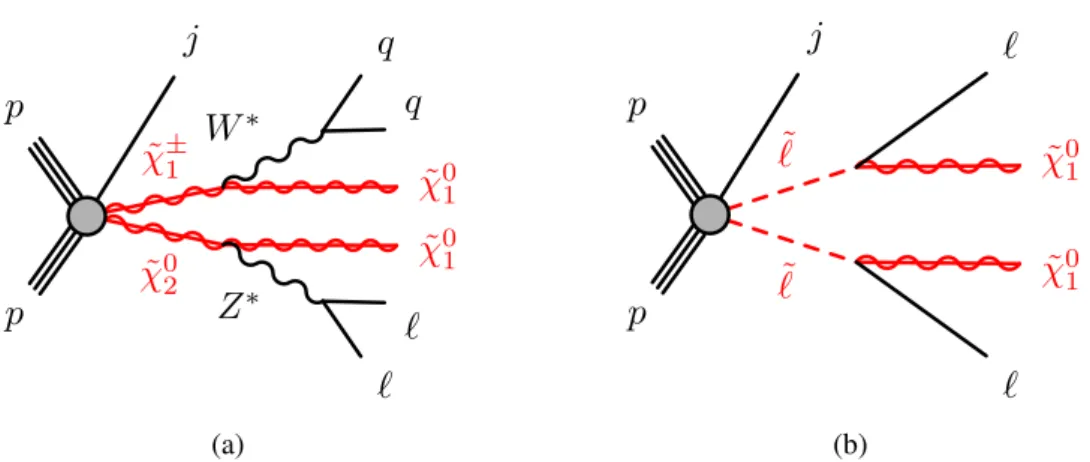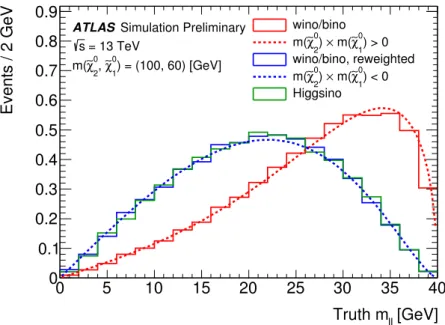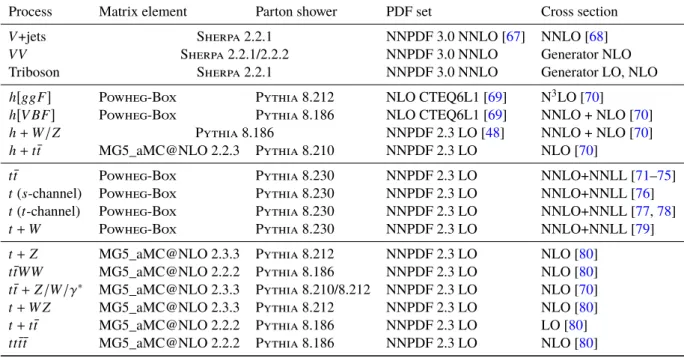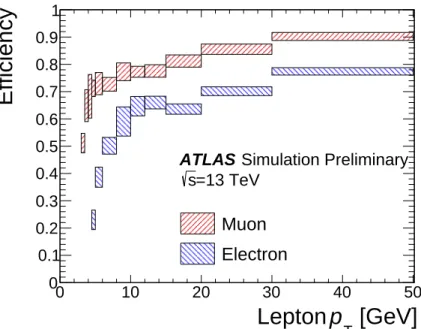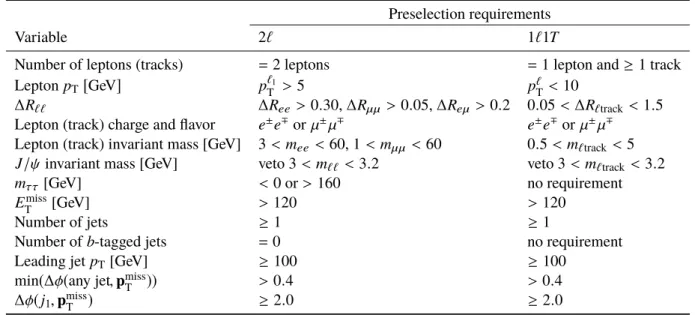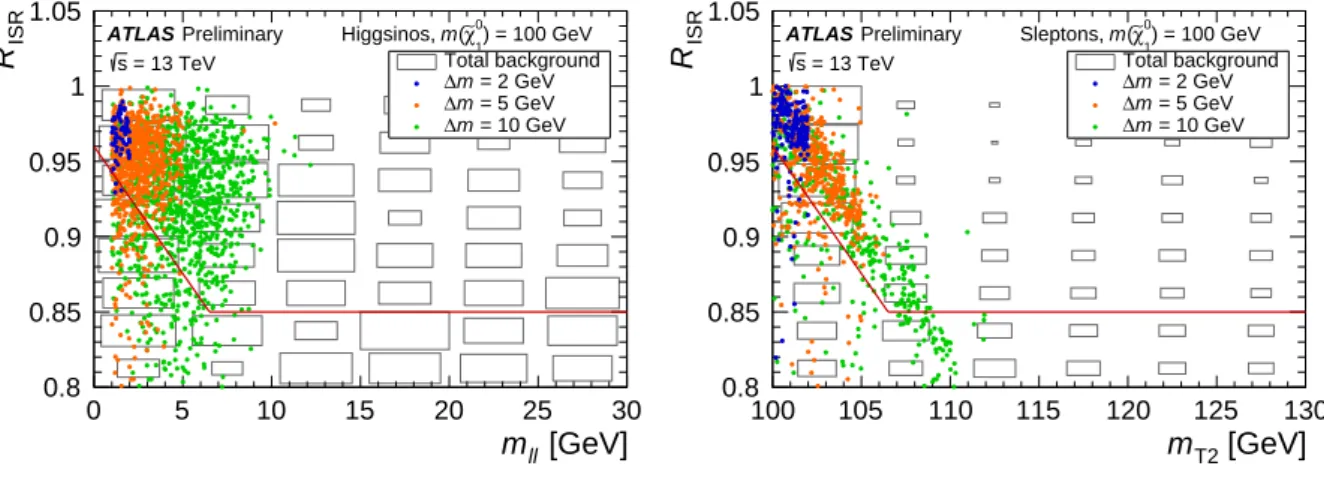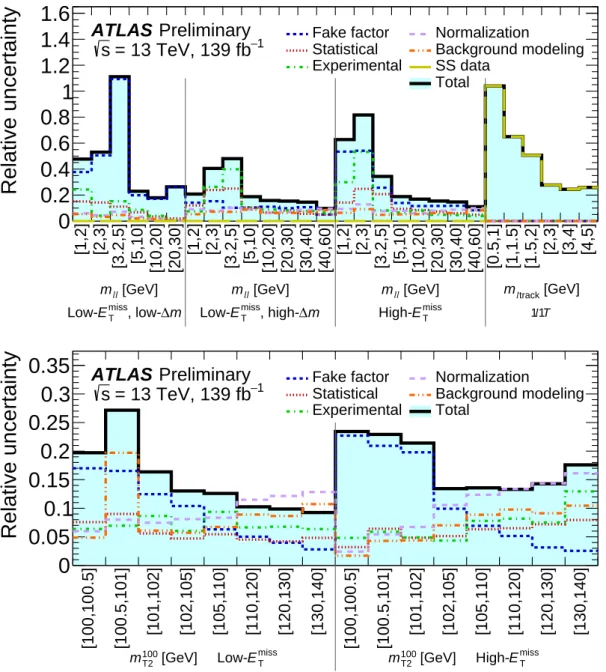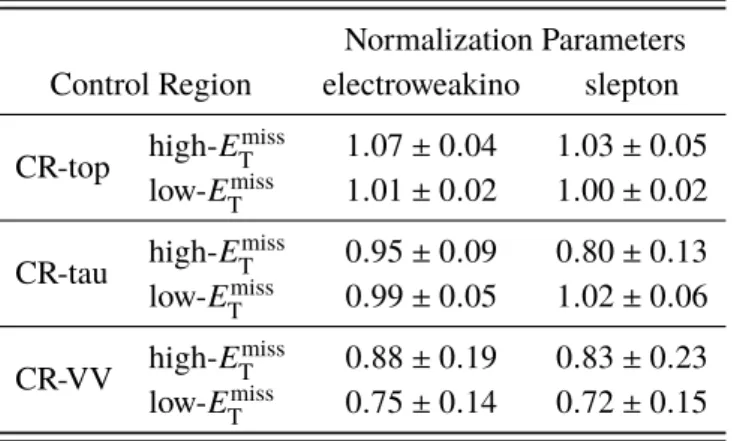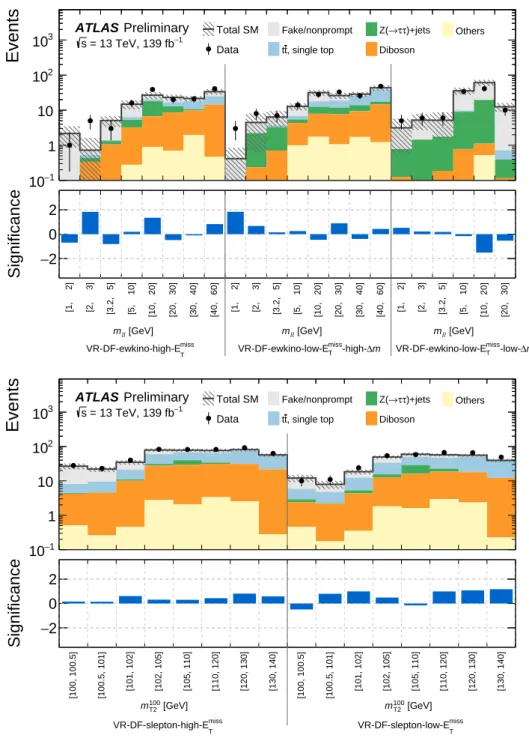A TLAS-CONF-2019-014 22 May 2019
ATLAS CONF Note
ATLAS-CONF-2019-014
22nd May 2019
Searches for electroweak production of
supersymmetric particles with compressed mass spectra in √
s = 13 TeV p p collisions with the ATLAS detector
The ATLAS Collaboration
This note presents results of searches for electroweak production of supersymmetric particles in models with compressed mass spectra. The searches use 139 fb − 1 of
√ s = 13 TeV proton- proton collision data collected by the ATLAS experiment at the Large Hadron Collider. Events with missing transverse momentum, two same-flavour, oppositely-charged, low transverse momentum leptons, and hadronic activity from initial state radiation are selected. The data are found to be consistent with predictions from the Standard Model. The results are interpreted using simplified models of R -parity-conserving supersymmetry in which the lightest supersymmetric partner is a neutralino with a mass similar to a chargino, heavier neutralino, or slepton. Lower limits on the masses of charginos in different simplified models range from 162 GeV to 205 GeV for moderate mass splittings, and extend down to mass splittings of 2 GeV to 2.6 GeV at the LEP chargino bounds. Similar lower limits on degenerate light-flavour sleptons reach up to masses of 256 GeV and down to mass splittings of 590 MeV.
© 2019 CERN for the benefit of the ATLAS Collaboration.
Reproduction of this article or parts of it is allowed as specified in the CC-BY-4.0 license.
1 Introduction
Extensions to the Standard Model (SM) that include new states with nearly-degenerate masses can help resolve problems in particle physics while evading constraints from colliders. The mass spectra of such new states are referred to in this paper as “compressed”. In many models of Supersymmetry (SUSY) [1–6]
one of the new particles produced in proton-proton ( pp ) collisions is assumed to be the lightest neutralino e χ 0
1 . In the compressed SUSY models considered in this paper, the e χ 0
1 is close in mass to a heavier SUSY partner such as a chargino ( e χ ±
1 ), second-lightest neutralino ( e χ 0
2 ), or slepton ( e ` ). If the e χ 0
1 is stable, e.g. as the lightest SUSY partner (LSP) in R -parity conserving SUSY models [7], then it is a viable dark matter candidate [8, 9].
This note presents searches for physics beyond the SM in signatures sensitive to models with compressed mass spectra. Simplified SUSY models [10–12] are used to optimise the searches and interpret the results. The searches use 13 TeV proton–proton ( pp ) collision data corresponding to 139 fb − 1 of integrated luminosity, collected by the ATLAS experiment [13] from 2015 to 2018 at the CERN Large Hadron Collider (LHC).
All searches assume pair production of SUSY particles via electroweak interactions, with subsequent decays to the e χ 0
1 and SM particles. The neutralinos ˜ χ 0
1 , 2 , 3 , 4 and charginos ˜ χ ±
1 , 2 are collectively referred to as electroweakinos, where the subscripts indicate increasing electroweakino mass. These mass eigenstates are a mixture of wino, bino, and Higgsino fields1 which form the SUSY partners of the SM W , γ/Z , and Higgs fields, respectively. In the minimal supersymmetric extension of the SM (MSSM) [14, 15], the masses of the bino, wino, and Higgsino states are parameterised by M 1 , M 2 , and µ , respectively. For large values of tan ( β) , these three parameters drive the phenomenology of the electroweakinos
Three SUSY scenarios are considered in the interpretation of the searches. In the first scenario, the lightest SUSY partners are assumed to be a triplet of Higgsino-like states ( e χ 0
1 , e χ ±
1 , e χ 0
2 ), in which the mass splitting between the states is partially determined by the magnitude of M 1 or M 2 relative to | µ| . Such a scenario, referred to here as Higgsino models, is motivated by naturalness arguments [16, 17], which suggest that | µ|
should be near the weak scale [18, 19] while M 1 and/or M 2 can be larger. The second scenario is similar to the first, except with | M 1 | < | M 2 | | µ| , so that the produced electroweakinos have wino and/or bino nature.
In such wino/bino scenarios the LSP can be a thermal relic dark matter candidate that was depleted in the early universe through coannihilation processes to match the observed dark matter density [20, 21]. Such scenarios are also less constrained by dark matter direct detection experiments than Higgsino models [22].
Diagrams representing the production mode for the first two scenarios are shown in Figure 1(a). A e χ 0
2
produced in either scenario can decay to a dilepton pair via an off-shell Z boson ( Z ∗ ), such that the dilepton invariant mass m `` is kinematically restricted to be smaller than the mass splitting between the e χ 0
2 and e χ 0
1 . Hadronic initial-state radiation (ISR) is also required to boost the system as a way of enhancing the sensitivity of the search.
The third scenario assumes the presence of scalar partners of the SM leptons (slepton, ` e ) that are slightly heavier than a bino-like LSP. Such models can explain both dark matter thermal relic densities through coannihilation channels, as well as the muon g − 2 anomaly [23, 24]. This process is illustrated in Figure 1(b). This scenario exploits the relationship of the leptons and the missing transverse momentum through the stransverse mass, m T2 [25, 26], which exhibits a kinematic endpoint similar to that for m `` in electroweakino decays.
1 In the minimal supersymmetric extension of the SM the Higgs sector is extended to contain two Higgs doublets.
˜ χ ± 1
˜ χ 0 2
W ∗
Z ∗ p
p
˜ χ 0 1 q q
˜ χ 0 1
`
` j
(a)
` ˜
` ˜ p
p
j
˜ χ 0 1
`
˜ χ 0 1
`
(b)
Figure 1: Diagrams representing the two-lepton final state of (a) production of electroweakino e χ 0
2 e χ ±
1 with initial-state radiation ( j ), and (b) slepton pair `e e ` production in association with initial state radiation ( j ). The Higgsino simplified model also considers e χ 0
2 e χ 0
1 and e χ +
1 e χ −
1 production.
Events with two same-flavour opposite-charge leptons (electrons or muons), significant missing transverse energy ( E miss
T ), and hadronic activity are selected for all scenarios. Signal regions (SRs) are defined by placing additional requirements on a number of kinematic variables. The dominant SM backgrounds are either estimated with in situ techniques or constrained using data control regions (CRs) that enter into a simultaneous likelihood fit with the SRs. The fit is performed in bins of either the m `` distribution (for electroweakinos) or the m T2 distribution (for sleptons).
Collider constraints on these compressed scenarios were first established at LEP [27–37]. The lower bounds on direct chargino production from these results correspond to m( e χ ±
1 ) > 103 . 5 GeV for ∆m( e χ ±
1 , e χ 0
1 ) > 3 GeV and m( e χ ±
1 ) > 92 . 4 GeV for smaller mass differences, although the lower bound on the chargino mass weakens to around 75 GeV for models with additional new scalars and Higgsino-like cross sections [38].
For sleptons, conservative lower limits on the mass of the scalar partner of the right-handed muon, denoted e µ R , are approximately m( e µ R ) & 94 . 6 GeV for mass splittings down to m( e µ R ) − m( e χ 0
1 ) & 2 GeV. For
the scalar partner of the right-handed electron, denoted e e R , LEP established a universal lower bound of
m( e e R ) & 73 GeV that is independent of ∆m( e e R , e χ 0
1 ) . Recent papers from the CMS [39, 40] and ATLAS [41]
collaborations have extended the LEP limits for a range of mass splittings. This note extends previous LHC results by increasing the integrated luminosity, extending the search with additional channels, and exploiting improvements in detector calibration and performance. The event selection was also reoptimised and uses techniques based on Recursive Jigsaw Reconstruction [42], which improve the separation of the SUSY signal from the SM backgrounds.
The rest of the note proceeds as follows. After a short description of the ATLAS detector, a summary of
data and simulation samples used is presented. This is followed by descriptions of the event reconstruction,
signal regions, background estimates, and systematic uncertainties. The results of the search are then
presented, along with the interpretation of the results in the benchmark SUSY models. A brief conclusion
is presented at the end.
2 ATLAS Detector
The ATLAS experiment is a general-purpose particle detector that surrounds the interaction point with nearly 4 π solid angle coverage.2 It comprises an inner detector, calorimeter systems, and a muon spectrometer.
The inner detector provides precision tracking of charged particles in the pseudorapidity region |η| < 2 . 5, consisting of pixel and microstrip silicon subsystems within a transition radiation tracker. The innermost pixel detector layer, the insertable B-layer [43], was added for
√ s = 13 TeV data-taking to improve tracking performance. These are immersed in a 2 T axial magnetic field provided by a superconducting solenoid.
High-granularity lead/liquid-argon electromagnetic sampling calorimeters are used for |η| < 3 . 2. Hadronic energy deposits are measured in a steel/scintillator tile barrel calorimeter in the |η | < 1 . 7 region. Forward calorimeters cover the region 3 . 2 < |η| < 4 . 9 for both electromagnetic and hadronic measurements.
The muon spectrometer comprises trigger and high-precision tracking chambers spanning |η| < 2 . 4 and
|η| < 2 . 7, respectively, with a magnetic field provided by three large superconducting toroidal magnets.
Events of interest are selected using a two-level trigger system [44], consisting of a first-level trigger implemented in hardware, which is followed by a software-based high-level trigger.
3 Data and Simulated Event Samples
Events were selected with a E miss
T trigger, employing varied trigger thresholds as a function of the data period, that is fully efficient for offline E miss
T values above 200 GeV for all periods. The dataset used corresponds to 139 fb − 1 of
√ s = 13 TeV pp collision data, where the uncertainty on the integrated luminosity is 1.7%. It is derived from the calibration of the luminosity scale using x - y beam-separation scans, following a methodology similar to that detailed in Ref. [45], and using the LUCID-2 detector for the baseline luminosity measurements [46]. The average number of interactions per bunch-crossing was 33.7.
Samples of Monte Carlo (MC) simulated events are used to estimate the signal yields, and for estimating the background from process with prompt leptons, as well as in the determination of systematic uncertainties.
For the first signal scenario, samples were generated for the Higgsino simplified model production of χ ˜ −
1 χ ˜ +
1 , ˜ χ 0
2 χ ˜ ±
1 and ˜ χ 0
2 χ ˜ 0
1 . The masses of the neutralinos ( ˜ χ 0
1 , 2 ) were varied while the chargino mass was set to ˜ χ ±
1 = 1 2 m( χ ˜ 0
1 ) + m( χ ˜ 0
2 )
. Mass splittings in the case of pure Higgsinos are generated by radiative corrections, and are of the order of hundreds of MeV [47]. Mass splittings of the order of tens of GeV can be obtained by introducing mixing with wino or bino states. In this simplified model, mass differences ranging from 1 GeV to 60 GeV are considered, but the calculated cross sections assumed electroweakino mixing matrices corresponding to pure Higgsino e χ 0
2 , e χ ±
1 and e χ 0
1 states, and all other SUSY particles are decoupled. Example values of cross sections for m( e χ 0
2 ) = 110 GeV and m( e χ 0
1 ) = 100 GeV are 4 . 3 ± 0 . 1 pb for e χ 0
2 e χ ±
1 production and 2 . 73 ± 0 . 07 pb for e χ 0
2 e χ 0
1 production. The samples were generated at leading order (LO) with MG5_aMC@NLO 2.6.1 using the NNPDF23LO [48] parton distribution function (PDF) set and included up to two extra partons in the matrix element (ME). The electroweakinos were decayed with
2 ATLAS uses a right-handed coordinate system with its origin at the nominal interaction point (IP) in the center of the detector and the z -axis along the beam pipe. The x -axis points from the IP to the center of the LHC ring, and the y -axis points upwards.
Cylindrical coordinates (r, φ) are used in the transverse plane, φ being the azimuthal angle around the z -axis. The pseudorapidity is defined in terms of the polar angle θ as η = − ln tan ( θ / 2 ) . Angular distance is measured in units of ∆R ≡ p
(∆η ) 2 + (∆φ ) 2 .
Rapidity is defined by y = 1 2 ln [( E + p z )/( E − p z )] , where E is the energy and p z is the longitudinal component of the
momentum along the beam direction.
0 5 10 15 20 25 30 35 40 [GeV]
Truth m ll
0 0.1 0.2 0.3 0.4 0.5 0.6 0.7 0.8 0.9
Events / 2 GeV
wino/bino ) > 0
0
χ
1m( ∼ ) ×
0
χ
2m( ∼
wino/bino, reweighted ) < 0
0
χ
1m( ∼ ) ×
0
χ
2m( ∼ Higgsino ATLAS Simulation Preliminary
= 13 TeV s
) = (100, 60) [GeV]
0
χ
1, ∼
0
χ
2m( ∼
Figure 2: Dilepton invariant mass for Higgsino and wino/bino simplified models. The endpoint of the distribution is determined by the difference between the masses of the ˜ χ 0
2 and ˜ χ 0
1 . The results from simulation (histograms) are compared against analytic calculations of the expected lineshape (dashed lines) presented in Ref. [53]. The product of the signed mass eigenvalues m χ ˜ 0
2
× m χ ˜ 0
1 is negative for Higgsino and can be either negative or positive for wino/bino scenarios.
with MadSpin [49]. The events were then interfaced with Pythia 8.212 [50] to model the parton shower (PS), hadronisation, and underlying event (UE) using the A14 set of tuned parameters (tune) [51]. The ME-PS matching was performed using the CKKW-L scheme [52] with the merging scale set to 15 GeV.
To enforce an ISR topology, at least one parton in the final state is required to have a transverse momentum ( p T ) greater than 50 GeV. Possible diagrams including coloured SUSY particles were excluded from the generation.
In the wino/bino scenario, the generated process is pp → χ ˜ 0
2 χ ˜ ±
1 . The ˜ χ 0
1 is a pure bino state, with the ˜ χ 0
2 and ˜ χ ±
1 states forming degenerate pure wino states. The generator configurations as well as the electroweakino decay branching ratios are consistent with those for the Higgsino samples. An example value of e χ 0
2 e χ ±
1 production cross-section for m( e χ 0
2 ) = m( e χ ±
1 ) = 110 GeV is 16 . 0 ± 0 . 5 pb.
The electroweakino searches exploit the kinematic endpoint in the dilepton invariant mass spectrum from the decay chain ˜ χ 0
2 → Z ∗ χ ˜ 0
1 , Z ∗ → `` . Therefore, processes that involve the production of a ˜ χ 0
2
neutralino dominate the sensitivity of the search. The branching ratios for the processes ˜ χ 0
2 → Z ∗ χ ˜ 0
1 and χ ˜ ±
1 → W ±∗ χ ˜ 0
1 were fixed to 100% for all above scenarios. The branching ratios of Z ∗ → `` and W ±∗ → `ν depend on the invariant mass of the off-shell vector boson. For consistency with previous searches in the wino/bino scenario, the Z ∗ → `` branching ratios were set to a constant value corresponding to the on-shell Z branching ratios. For the Higgsino simplified model, the branching ratios were computed with SUSY-HIT 1.5a [54] which accounts for finite b -quark and τ masses. At ∆m χ ˜ 0
2 , χ ˜ 0
1
= 40 GeV the Z ∗ → `` branching ratio for electrons or muons is 3.5%. This increases to 5.3% and 5.0% respectively at
∆m χ ˜ 0
2 , χ ˜ 0
1
= 1 GeV due to the kinematic inaccessibility of heavier quarks and τ leptons. Similarly for W ∗ → `ν the branching ratios to electrons or muons are both 11% at a mass splitting of 40 GeV, which increases to 20% and 17% respectively with ∆m χ ˜ 0
2 , χ ˜ 0
1
= 1 GeV. The lineshape of the dilepton invariant
mass from the decay of the virtual Z ∗ depends on the relative sign of the e χ 0
1 and e χ 0
2 mass parameters. In the pure Higgsino case the product of the signed mass eigenvalues m χ ˜ 0
2
× m χ ˜ 0
1 is negative, while for the wino/bino case either m χ ˜ 0
2
× m χ ˜ 0
1
< 0 or m χ ˜ 0
2
× m χ ˜ 0
1
> 0 can occur. The generated wino/bino process assumes the product of the signed mass eigenstates is positive and the analytical description of the expected lineshape is used to reweight the m `` distribution to the negative product assumption. The difference between wino/bino and Higgsino lineshapes, as well as the reweighted distribution’s agreement with the expected lineshape is shown in Figure 2.
For the third scenario, samples with direct production of selectrons ˜ e L,R or smuons ˜ µ L, R are generated.
The L, R subscripts denote left- or right-handed chirality of the sleptons. All sleptons flavours and chirality contributions are assumed to be degenerate in mass. An example value of the slepton production cross-section for m(e ` L,R ) = 110 GeV is 0 . 55 ± 0 . 01 pb. These particles are decayed with a 100% branching ratio to their corresponding SM partner lepton and a pure bino neutralino, ˜ χ 0
1 . The slepton samples were generated with MG5_aMC@NLO 2.6.1 and interfaced with Pythia 8.230. The PDF set used was NNPDF2.3LO with the A14 tune. Similar to the the Higgsino and wino/bino samples, CKKW-L merging was used for the ME-PS matching [55], with the merging scale set to a quarter of the sleptons’ mass.
Cross sections for the signal scenarios are calculated with Resummino 2.0.1 [56–58] at NLL+NLO precision. The evaluation of the cross section and corresponding uncertainty are taken from an envelope of cross section predictions using different PDF sets, and varied factorisation and normalisation scales. This procedure is described in more detail in Ref. [59], and is the same procedure used in the previous search result [41].
The SM processes are estimated from a combination of Monte Carlo (MC) simulation as well as data-driven approaches. The latter are described in Section 6. Sherpa 2.2.1 and 2.2.2 [60] were used to model the V +jets ( V = W, Z, γ ∗ ) samples involving leptonically decaying vector bosons, as well as diboson ( WW , Z Z and W Z , collectively referred to as VV ), and fully leptonic triboson processes. Vector boson fusion (VBF) and gluon-gluon fusion (ggF) single higgs production were generated with Powheg-Box [61], while higgs production in association with a massive vector boson was generated with Pythia 8.186, and ttH production was generated with MG5_aMC@NLO 2.2.3. Single top, t t ¯ , and top quarks produced in association with W bosons were all generated with Powheg-Box. Rarer top processes all used MG5_aMC@NLO (versions 2.2.2/2.3.3). ME processes, excluding those generated with Pythia or Sherpa, were then interfaced with Pythia 8 using the ME+PS prescription. Further details on the configuration of the SM processes can be found in Refs. [62–66]. A summary of the generator configurations, including the PDF sets and cross sections used for normalisation is found in Table 1.
To simulate the effects of additional pp collisions, referred to as pileup, in the same and neighbouring bunch crossings, additional interactions were generated using the soft QCD processes of Pythia 8.186 with the A3 tune [81] and the MSTW2008LO PDF set [82], and were overlaid onto each simulated hard-scatter event. The MC samples were reweighted to match the pileup distribution observed in the data.
All MC simulated samples were processed through the ATLAS simulation framework [83] in Geant4 [84].
The samples for the signal scenarios made use of the ATLAS fast simulation, which parameterises the response of the calorimeters. Background and signal samples made use of EvtGev 1.6.0 and 1.2.0 [85]
to model the decay of bottom and charm quarks, with exception to background samples modelled with
Sherpa.
Process Matrix element Parton shower PDF set Cross section
V +jets Sherpa 2.2.1 NNPDF 3.0 NNLO [67] NNLO [68]
VV Sherpa 2.2.1/2.2.2 NNPDF 3.0 NNLO Generator NLO
Triboson Sherpa 2.2.1 NNPDF 3.0 NNLO Generator LO, NLO
h [ ggF ] Powheg-Box Pythia 8.212 NLO CTEQ6L1 [69] N 3 LO [70]
h [ V BF ] Powheg-Box Pythia 8.186 NLO CTEQ6L1 [69] NNLO + NLO [70]
h + W / Z Pythia 8.186 NNPDF 2.3 LO [48] NNLO + NLO [70]
h + t t ¯ MG5_aMC@NLO 2.2.3 Pythia 8.210 NNPDF 2.3 LO NLO [70]
t t ¯ Powheg-Box Pythia 8.230 NNPDF 2.3 LO NNLO+NNLL [71–75]
t ( s -channel) Powheg-Box Pythia 8.230 NNPDF 2.3 LO NNLO+NNLL [76]
t ( t -channel) Powheg-Box Pythia 8.230 NNPDF 2.3 LO NNLO+NNLL [77, 78]
t + W Powheg-Box Pythia 8.230 NNPDF 2.3 LO NNLO+NNLL [79]
t + Z MG5_aMC@NLO 2.3.3 Pythia 8.212 NNPDF 2.3 LO NLO [80]
t tWW ¯ MG5_aMC@NLO 2.2.2 Pythia 8.186 NNPDF 2.3 LO NLO [80]
t t ¯ + Z / W / γ ∗ MG5_aMC@NLO 2.3.3 Pythia 8.210/8.212 NNPDF 2.3 LO NLO [70]
t + W Z MG5_aMC@NLO 2.3.3 Pythia 8.212 NNPDF 2.3 LO NLO [80]
t + t¯ t MG5_aMC@NLO 2.2.2 Pythia 8.186 NNPDF 2.3 LO LO [80]
tt t ¯ t ¯ MG5_aMC@NLO 2.2.2 Pythia 8.186 NNPDF 2.3 LO NLO [80]
Table 1: Simulated SM background processes. The PDF set refers to that used in for the matrix element.
4 Event Reconstruction
Candidate events are required to have at least one reconstructed pp interaction vertex with a minimum of two associated tracks with p T > 500 MeV. In events with multiple vertices, the primary vertex is defined as the one with the highest Í
p 2
T of associated tracks. To reject events with detector noise or non-collision backgrounds, a set of basic quality criteria [86] are applied.
Leptons, jets and tracks are “preselected” using loose identification criteria, and must survive tighter
“signal” identification requirements in order to be selected for the search regions. Preselected leptons and jets are used in fake/nonprompt (FNP) background estimates as well as in resolving ambiguities between tracks and clusters associated with multiple lepton and jet candidates.
Isolation criteria are used in the definition of signal leptons, and are based on tracking information, calorimeter clusters, or both. Isolation energies are computed as a Í
p T of nearby activity, excluding the contributions from nearby leptons, and are effective in reducing contributions from semileptonic heavy-flavour hadron decays and jets faking prompt leptons. The isolation requirements used in this analysis are based on those described in Refs. [87] and [88], with updates to improve their performance under the increased pileup conditions encountered in the 2017 and 2018 data samples.
Electrons are required to have p T > 4 . 5 GeV and |η | < 2 . 47. Preselected electrons are further required to pass the calorimeter- and tracking-based VeryLoose likelihood identification [88], and to have a longitudinal impact parameter z 0 relative to the primary vertex that satisfies | z 0 sin θ| < 0 . 5 mm. Signal electrons must satisfy the Medium identification criterion [88], and be compatible with originating from the primary vertex, with the significance of the transverse impact parameter defined relative to the beam position satisfying
| d 0 |/σ(d 0 ) < 5. Signal electrons are further refined using the Gradient isolation working point [88], which
uses both tracking and calorimeter information.
0 10 20 30 40 50
[GeV]
p T
Lepton
0 0.1 0.2 0.3 0.4 0.5 0.6 0.7 0.8 0.9 1
Efficiency
Muon Electron
Simulation Preliminary ATLAS
=13 TeV s
Figure 3: Signal lepton efficiencies for electrons and muons in a mix of slepton and Higgsino samples. Combined reconstruction, identification, isolation and vertex association efficiencies are shown for leptons within detector acceptance, and with lepton p T within a factor of 3 of ∆m(e `, e χ 0
1 ) for sleptons or of ∆m(e `, e χ 0
1 )/ 2 for Higgsinos. The average number of interactions per crossing in the MC samples is h µi = 33 . 7. Uncertainty bands represent the range of efficiencies observed across all signal samples used for the given p T bin. The η -dependence is consistent with values reported in ATLAS combined performance papers.
Muons are required to satisfy p T > 3 GeV and |η| < 2 . 5. Preselected muons are identified using the LowPt criterion, a re-optimised selection similar to those defined in Ref. [87] but with improved signal efficiency and background rejection for p T < 10 GeV muon candidates. Preselected muons must also satisfy
| z 0 sin θ| < 0 . 5 mm. From the remaining preselected muons, signal muons must satisfy |d 0 |/σ(d 0 ) < 3.
Finally, signal muons are required to pass the FCTightTrackOnly isolation working point, which uses only tracking information.
After all lepton selection criteria are applied, the efficiency for reconstructing and identifying signal electrons within the detector acceptance in the Higgsino and slepton signal samples ranges from 20% for p T = 4 . 5 GeV to over 75% for p T > 30 GeV. The corresponding efficiency for signal muons ranges from approximately 50% at p T = 3 GeV to 90% for p T > 30 GeV. The efficiency for signal electrons and muons in a mix of slepton and Higgsino samples is shown in Fig. 3 as a function of lepton p T .
Preselected jets are reconstructed from calorimeter topological energy clusters [89] in the region |η | < 4 . 5 using the anti- k t algorithm [90, 91] with radius parameter R = 0 . 4. The jets are required to have p T > 20 GeV after being calibrated in accord with Ref. [92] and having the expected energy contribution from pileup subtracted according to the jet area [93]. In order to suppress jets due to pileup, jets with p T < 120 GeV and |η| < 2 . 5 are required to satisfy the Medium working point of the jet vertex tagger [93], which uses information from the tracks associated to the jet. From the sample of preselected jets, signal jets are selected if they satisfy p T > 30 GeV and |η| < 2 . 8.
Jets identified as containing b -hadron decays, referred to as b -tagged jets, are identified from preselected
jets within |η | < 2 . 5 using the MV2c10 algorithm [94, 95]. The p T > 20 GeV requirement is maintained to
maximise the rejection of the t t ¯ background. The b -tagging algorithm working point is chosen so that b -jets
from simulated t¯ t events are identified with an 85% efficiency, with rejection factors of 3 for charm-quark jets and 34 for light-quark and gluon jets.
The following procedure is used to resolve ambiguities between the reconstructed leptons and jets. It employs the distance measure ∆R y = p
(∆y) 2 + (∆φ) 2 , where y is the rapidity. Electrons that share an inner detector track with a muon candidate are discarded to remove bremsstrahlung from muons followed by a photon conversion. Non- b -tagged jets that are separated from the remaining electrons by ∆R y < 0 . 2 are removed. Jets containing a muon candidate within ∆R y < 0 . 4 and with fewer than three tracks with p T > 500 MeV are removed to suppress muon bremsstrahlung. Electrons or muons with ∆R y < 0 . 4 from surviving jet candidates are removed to suppress bottom and charm hadron decays.
In order to increase the efficiency for signals with the lowest mass splittings, where the lepton p T can be very low, signal regions based on a signal lepton and an isolated low- p T track are used. For these regions the track is selected to be matched to a reconstructed electron or muon candidate with no identification requirements. Preselected tracks with p T > 500 MeV and η < 2 . 5 are selected using the Tight-Primary working point defined in Ref. [96]. Signal tracks are required to be within ∆R < 0 . 01 of a reconstructed electron or muon candidate. Electron (muon) candidates can be reconstructed with transverse momenta as low as 1 (2) GeV, and are required to fail the signal requirements defined above to avoid any overlap.
Signal tracks with p T that differs from the transverse momentum of the matched lepton by more than 20%
are rejected. The track-lepton matching allows for the tracks to be identified as electron or muon tracks, reducing backgrounds from tracks not originating from the leptonic decay of a SUSY particle. Signal tracks must also satisfy dedicated isolation criteria – they are required to be separated from preselected jets by at least ∆R > 0 . 5, and the Í
p T of preselected tracks within ∆R < 0 . 3 of signal tracks, excluding the contributions from nearby leptons, is required to be smaller than 0 . 5 GeV. Finally, signal tracks must satisfy p T > 1 GeV, | z 0 sin θ | < 0 . 5 mm and | d 0 |/σ(d 0 ) < 3. The efficiency of selecting signal tracks for the studied electroweakino signals is 20% for electrons with 3 < p T < 4 GeV and 35% for muons with 2 < p T < 3 GeV.
Small corrections are applied to reconstructed electrons, muons, b -tagged jets, and tracks in the simulated samples to match the reconstruction efficiencies in data. The corrections for b -tagged jets account for the differences between data and simulated samples in the identification efficiencies for jets including b -hadron decays, as well as mis-identification rates of c -, and light-flavour / gluon initiated jets. The corrections for low-momentum leptons are obtained from J /ψ → ee/µµ events with the same tag-and-probe methods as used for higher- p T electrons [88] and muons [87]. The corrections used to account for track-lepton matching efficiency differences in data and simulation are derived with J/ψ events decaying to a low- p T signal lepton and a preselected track. The track isolation corrections are measured using Z events decaying to a signal lepton and a track matched to a reconstructed lepton candidate. All track corrections are found to be compatible with 1. Dedicated scale factors are also applied in MC to properly model the trigger efficiency observed in data. These scale factor are measured in events selected with single muon triggers, passing kinematic selections similar to the ones used to define the SRs. They are parametrised as a function of E miss
T and found to vary between 0.9 and 1 in the E miss
T range of interest. An uncertainty of 5% is assigned to the scale factors to cover their dependence with other kinematic quantities.
The missing transverse momentum p miss
T , with magnitude E miss
T , is defined as the negative vector sum of the transverse momenta of all reconstructed objects (electrons, muons, jets, and photons [97]) and an additional soft term. A dedicated overlap removal procedure is used to resolve ambiguities between the reconstructed objects [98]. The soft term is constructed from all tracks that are not associated with any lepton or jet, but that are associated with the primary vertex. In this way, E miss
T is adjusted for the best
calibration of jets and leptons, while maintaining pileup independence in the soft term [98].
Preselection requirements
Variable 2 ` 1 ` 1 T
Number of leptons (tracks) = 2 leptons = 1 lepton and ≥ 1 track
Lepton p T [ GeV ] p `
1T > 5 p `
T < 10
∆R `` ∆R ee > 0 . 30, ∆R µµ > 0 . 05, ∆R eµ > 0 . 2 0 . 05 < ∆R ` track < 1 . 5 Lepton (track) charge and flavor e ± e ∓ or µ ± µ ∓ e ± e ∓ or µ ± µ ∓
Lepton (track) invariant mass [GeV] 3 < m ee < 60, 1 < m µµ < 60 0 . 5 < m ` track < 5 J /ψ invariant mass [GeV] veto 3 < m `` < 3 . 2 veto 3 < m `track < 3 . 2
m ττ [GeV] < 0 or > 160 no requirement
E miss
T [GeV] > 120 > 120
Number of jets ≥ 1 ≥ 1
Number of b -tagged jets = 0 no requirement
Leading jet p T [GeV] ≥ 100 ≥ 100
min (∆φ( any jet , p miss
T )) > 0 . 4 > 0 . 4
∆φ( j 1 , p miss
T ) ≥ 2 . 0 ≥ 2 . 0
Table 2: Preselection requirements applied to all events entering into electroweakino and slepton search regions.
5 Signal Regions
Events entering into all SRs share a common preselection, with requirements listed in Table 2. The 1 ` 1 T channel requires exactly one signal lepton and at least one signal track of the same flavour and opposite electric charge (OS); all other regions require exactly two OS signal leptons, also of the same flavour. In regions with two leptons, the higher- p T lepton is denoted the “leading” lepton ( ` 1 ) while the lower- p T lepton is the “subleading” lepton ( ` 2 ).
Preselection requirements are employed to reduce backgrounds and form a basis for SRs and CRs used in the simultaneous fit. The leading lepton is required to have p T > 5 GeV, which reduces backgrounds from FNP leptons. Pairs of electrons are required to be separated by ∆R ee > 0 . 3 to avoid reconstruction inefficiencies due to overlapping electron showers in the EM calorimeter, while electrons and muons are likewise required to be separated by ∆R eµ > 0 . 2 to avoid energy deposits from muons spoiling electron shower shapes. An additional requirement that m `` be outside of [ 3 . 0 , 3 . 2 ] GeV removes contributions from J/ψ decays, while requiring m `` < 60 GeV reduces contributions from on-shell Z -boson decays.
Contributions from other hadronic resonances, e.g. Υ states, are expected to be negligible in the search regions and are not explicitly vetoed. Requirements on the minimal angular separation between the lepton candidates ( ∆R `` ) and invariant mass ( m `` ) removes events in which an energetic photon produces collinear lepton pairs.
The m ττ variable [99–101] is defined as m ττ = sign m 2 ττ q m ττ 2
, which is the signed square root of m ττ 2 ≡ 2 p ` 1 · p ` 2 ( 1 + ξ 1 )( 1 + ξ 2 ) , where p ` 1 and p ` 2 are the lepton four-momenta, while the parameters ξ 1 and ξ 2 are determined by solving p miss
T = ξ 1 p ` 1
T + ξ 2 p ` 2
T . The definition of m ττ approximates the invariant mass of a leptonically decaying τ -lepton pair if both τ -leptons are sufficiently boosted so that the neutrinos from each τ decay are collinear with the visible lepton momentum. The m ττ variable can be less than zero in events where one of the lepton momenta has a smaller magnitude than the E miss
T and points in the hemisphere opposite to the p miss
T vector. Events with 0 < m ττ < 160 GeV are rejected, a requirement that
reduces backgrounds from Z → ττ and has an efficiency greater than 80% for the signals considered.
Electroweakino SR Requirements
Variable Low- E miss
T , low- ∆m Low- E miss
T , high- ∆m High- E miss
T 1`1 T
E miss
T [GeV] [ 120 , 200 ] [ 120 , 200 ] > 200 > 200
E miss
T / H lep
T > 10 < 10 – > 30
∆φ( lep , p miss
T ) – – – < 1 . 0
Lepton or track p T [GeV] – p `
2T > 5 + m `` / 4 p `
2T > min ( 10 , 2 + m `` / 3 ) p track
T < 5 M S
T [GeV] < 50 – – –
m `
1T [GeV] – [ 10 , 60 ] < 60 –
R ISR – [ 0 . 8 , 1 . 0 ] [ max ( 0 . 85 , 0 . 98 − 0 . 02 × m `` ), 1 . 0 ] – Table 3: Requirements applied to all events entering into signal regions used for electroweakino searches.
The reconstructed E miss
T is required to be greater than 120 GeV in preselection, with higher thresholds applied to different SRs. For SUSY events in which much of the invisible momentum is carried by the e χ 0
1 pair, these requirements on E miss
T suggest that the SUSY system is recoiling against additional hadronic activity in the form of an ISR jet. All events are therefore required to have at least one jet with p T > 100 GeV, with that jet being separated from the p miss
T by at least 2.0 radians in φ . Additional jets in the event are also required to be separated from the p miss
T by min (∆ φ( any jet , p miss
T )) >0.4 in order to suppress the impact of jet energy mismeasurement on E miss
T . Events with one or more b -tagged jets with p T > 20 GeV ( N b− 20
jet ) are vetoed to reduce backgrounds from t¯ t production.
After applying the preselection requirements above, SRs are further optimised for specific SUSY scenarios.
Two categories of SRs are constructed: one for electroweakinos and the other targeting sleptons.
The SRs designed for sensitivity to electroweakinos are defined in Table 3. High- E miss
T regions require E miss
T > 200 GeV, where the online E miss
T triggers are fully efficient for the SUSY signal. Two Low- E miss
T
regions are constructed using events with 120 GeV < E miss
T < 200 GeV: one targeting electroweakinos with small mass splittings (Low- E miss
T , low- ∆m ), and one targeting mass splittings larger than ∼ 10 GeV (Low- E miss
T , high- ∆m ).
The p T threshold for the subleading lepton is defined with sliding cuts that retain efficiency for soft leptons from low- ∆m signals while reducing backgrounds from FNP leptons in events with larger values of m `` . The sliding requirement was optimised using a Z N significance metric [102] separately in each SR, considering signal models with a variety of masses and mass splittings.
The transverse mass of the leading lepton and E miss
T is defined as m ` 1
T = q 2 (E ` 1
T E miss
T − p ` 1
T · p miss
T ) and is used in the Low- E miss
T , high- ∆m and High- E miss
T regions to reduce contributions from fake and nonprompt leptons.
In events with high- p T ISR jets, the axis of maximum back-to-back p T , referred to here as the thrust axis, approximates the direction of the recoil between the ISR activity and the sparticle pair. The recursive jigsaw reconstruction (RJR) technique [42] is used to divide each event into two hemispheres perpendicular to the thrust axis: a supersymmetric particles hemisphere S , expected to contain the decay products of the electroweakinos or slepton pair and therefore the E miss
T ; and an ISR hemisphere, containing hadronic activity. This bisection allows the calculation of two discriminating variables that are useful in isolating events with ISR-induced E miss
T topologies: R ISR , the ratio between the E miss
T and the transverse momentum of the ISR system, and M S
T , the transverse mass of the S system. The R ISR variable in particular is sensitive
to the mass splitting, with values near 1.0 for the most compressed SUSY events. Figure 4 shows the
0 5 10 15 20 25 30 [GeV]
m ll
0.8 0.85 0.9 0.95 1 1.05
ISR R
Preliminary ATLAS
= 13 TeV s
) = 100 GeV
0
χ∼
1( m Higgsinos,
Total background = 2 GeV
∆ m = 5 GeV
∆ m
= 10 GeV
∆ m
100 105 110 115 120 125 130
[GeV]
m T2
0.8 0.85 0.9 0.95 1 1.05
ISR R
Preliminary ATLAS
= 13 TeV s
) = 100 GeV
0
